An Anti-Disturbance Resilience Enhanced Algorithm for UAV 3D Route Planning
Abstract
:1. Introduction
2. Resilience Enhancement Design for UAV 3D Route Planning
2.1. UAV Resilience
2.1.1. Ideas for the Realization of UAV Resilience
2.1.2. UAV Risk Identification to Determine a Mechanism of Determining the Reasonable Safety Range
2.1.3. Dynamic Track Planning of Online Real-Time Monitoring Mechanism
2.2. Risk Assessment of Mechanisms for Determining Reasonable Security Scope
2.2.1. Disturbance Analysis of UAV in Wind and Rain
2.2.2. Disturbance Classification Model Based on Gaussian Distribution
2.2.3. Disturbance Risk Prediction
2.2.4. Comprehensive Condition Discrimination Processor
2.3. Dynamic Route Planning of Online Real-Time Monitoring Mechanism
2.3.1. Track Planning Based on Improved A* Algorithm
2.3.2. Improved Resilience Algorithm Based on Artificial Potential Fields Algorithm
| Algorithm 1: Route Planning of Resilience Enhancement. | |
| Input 1: Coordinates of the initial node and the target node | 1 |
| Input 2: Current disturbance field level | 2 |
| Output: List of coordinates of planned route | 3 |
| Choose the appropriate distance according to the disturbance field level | 4 |
| Create Open-list and Close-list | 5 |
| Put the initial node into the Open-list | 6 |
| Repeat | 7 |
| If Open-list is empty | 8 |
| Break | 9 |
| Else | 10 |
| Add a ring of coordinates of the current node to the Open-list | 11 |
| Traverse the outer ring coordinates of the current ring node | 12 |
| The sensor records the current disturbance force | 13 |
| If Crash=Ture (the outer ring nodes meet obstacles) | 14 |
| Calculate tractive and repulsive forces | 15 |
| 16 | |
| 17 | |
| Else | 18 |
| 19 | |
| 20 | |
| Calculate the total cost of each node in the inner ring | 21 |
| Put the current node into the Close-list | 22 |
| If the current node is the target node | 23 |
| Break | 24 |
| If the current node has adjacent nodes | 25 |
| Add adjacent nodes to the Open-list | 26 |
| Return list of nodes planned | 27 |
3. Experimental Verifications
3.1. Experimental Environment
3.2. Deployment Algorithms
3.3. Risk Assessment of UAVs
3.4. Monte Carlo Simulation Verification
4. Conclusions
Author Contributions
Funding
Institutional Review Board Statement
Informed Consent Statement
Data Availability Statement
Conflicts of Interest
Appendix A
| Symbol | Meaning |
|---|---|
| vertical force of the rain | |
| pressure by raindrops | |
| effective area of the UAV’s body | |
| amount of precipitation | |
| density of the rainwater | |
| speed of the raindrops | |
| momentum loss of rainwater | |
| rain’s unit of time | |
| max driving force of the UAV along the Z-axis | |
| resilience coefficient fulfilling the flight safety | |
| UAV self-weight | |
| UAV load | |
| forecasted average wind speed | |
| maximum wind speed | |
| wind’s unit of time | |
| current wind speed measured by UAV | |
| speed of resilience | |
| mission required speed | |
| maximum speed that the UAV can reach in a no-wind | |
| UAV’s flight speed relative to the ground | |
| max force in the horizontal direction of the UAV | |
| air resistance coefficient | |
| air density | |
| equivalent area of the UAV in contact with the wind | |
| level of risk | |
| level of disturbance | |
| probability density function of the one-dimensional shift | |
| minimum safe distance of UAV | |
| diameter of the UAV | |
| UAV’s route offset | |
| estimated cost of the UAV’s distance from the target point | |
| cumulative path cost from the starting point to the ith node | |
| compensation penalty | |
| total cost function | |
| traction force | |
| repulsion force | |
| weighting factors of disturbance | |
| weighting factors of load | |
| final resultant force of the UAV |
References
- Xu, Z.; Lin, Y.; Yang, F.; Zhang, L.; Ma, X.; Liu, Y. A 3D Flight Route Planning Algorithm for UAV Based on the Idea of Resilience. In Proceedings of the 2021 10th International Conference on Computing and Pattern Recognition, Online. 4 February 2022; pp. 277–282. [Google Scholar]
- Gibson, J.; Schuler, T.; Mcguire, L.; Lofaro, D.M.; Sofge, D. Swarm and Multi-agent Time-based A* Path Planning for LTA3 Systems. Unmanned Syst. 2020, 8, 253–260. [Google Scholar] [CrossRef]
- Sang, H.; You, Y.; Sun, X.; Zhou, Y.; Liu, F. The hybrid path planning algorithm based on improved A* and artificial potential field for unmanned surface vehicle formations. Ocean Eng. 2021, 223, 108709. [Google Scholar] [CrossRef]
- Han, G.; Zhou, Z.; Zhang, T.; Wang, H.; Liu, L.; Peng, Y.; Guizani, M. Ant-Colony-Based Complete-Coverage Path-Planning Algorithm for Underwater Gliders in Ocean Areas with Thermoclines. IEEE Trans. Veh. Technol. 2020, 69, 8959–8971. [Google Scholar] [CrossRef]
- Yang, H.; Qi, J.; Miao, Y.; Sun, H.; Li, J.A. New Robot Navigation Algorithm Based on a Double-Layer Ant Algorithm and Trajectory Optimization. IEEE Trans. Ind. Electron. 2019, 66, 8557–8566. [Google Scholar] [CrossRef] [Green Version]
- Perumal, N.; Elamvazuthi, I.; Tageldeen, M.K.; Ahamed Khan, M.K.A.; Parasuraman, S. Mobile robot path planning using Ant Colony Optimization. In Proceedings of the 2016 2nd IEEE International Symposium on Robotics and Manufacturing Automation (ROMA), Ipoh, Malaysia, 25–27 September 2016; IEEE: Manhattan, NY, USA, 2017. [Google Scholar]
- Miao, C.; Chen, G.; Yan, C.; Wu, Y. Path planning optimization of indoor mobile robot based on adaptive ant colony algorithm. Comput. Ind. Eng. 2021, 156, 107230. [Google Scholar] [CrossRef]
- Huo, L.; Zhu, J.; Wu, G.; Li, Z. A novel simulated annealing based strategy for balanced UAV task assignment and path planning. Sensors 2020, 20, 4769. [Google Scholar] [CrossRef] [PubMed]
- Daryanavard, H.; Harifi, A. UAV Path Planning for Data Gathering of IoT Nodes: Ant Colony or Simulated Annealing Optimization. In Proceedings of the 2019 3rd International Conference on Internet of Things and Applications (IoT), Isfahan, Iran, 17–18 April 2019. [Google Scholar]
- Fu, W.; Yin, J. A Hybrid Path Planning Algorithm Based on Simulated Annealing Particle Swarm for The Self-driving Car. In Proceedings of the 2018 International Computers, Signals and Systems Conference (ICOMSSC), Dalian, China, 28–30 September 2018. [Google Scholar]
- Conesa-Munoz, J.; Pajares, G.; Ribeiro, A. Mix-opt: A new route operator for optimal coverage path planning for a fleet in an agricultural environment. Expert Syst. Appl. 2016, 54, 364–378. [Google Scholar] [CrossRef]
- Yu, X.; Li, C.; Yen, G.G. A knee-guided differential evolution algorithm for unmanned aerial vehicle path planning in disaster management. Appl. Soft Comput. 2020, 98, 106857. [Google Scholar] [CrossRef]
- Bonyadi, M.R.; Michalewicz, Z. Particle Swarm Optimization for Single Objective Continuous Space Problems: A Review. Evol. Comput. 2017, 25, 1–54. [Google Scholar] [CrossRef] [PubMed]
- Arjoune, Y.; Ghazi, H.E.; Kaabouch, N.; El Majd, B.A. A particle swarm optimization based algorithm for primary user emulation attack detection. In Proceedings of the IEEE Computing & Communication Workshop & Conference, Las Vegas, NV, USA, 8–10 January 2018; pp. 823–827. [Google Scholar]
- Ni, S.; Liu, Z.; Huang, D.; Cai, Y.; Wang, X.; Gao, S. An application-orientated anti-collision path planning algorithm for unmanned surface vehicles. Ocean Eng. 2021, 235, 109298. [Google Scholar] [CrossRef]
- Liu, L.; Shi, R.; Li, S.; Wu, J. Path planning for UAVS based on improved artificial potential field method through changing the repulsive potential function. In Proceedings of the Guidance, Navigation & Control Conference, Nanjing, China, 12–14 August 2016. [Google Scholar]
- Zhou, Z.; Wang, J.; Zhu, Z.; Yang, D.; Wu, J. Tangent navigated robot path planning strategy using particle swarm optimized artificial potential field. Optik 2018, 158, 639–651. [Google Scholar] [CrossRef]
- Wang, S.; Zhang, J.; Zhang, J. Artificial potential field algorithm for path control of unmanned ground vehicles formation in highway. Electron. Lett. 2018, 54, 1166–1168. [Google Scholar] [CrossRef]
- Bounini, F.; Gingras, D.; Pollart, H.; Grurer, D. Modified Artificial Potential Field Method for Online Path Planning Applications. In Proceedings of the Intelligent Vehicles Symposium, Los Angeles, CA, USA, 11–14 June 2017. [Google Scholar]
- Mitra, S.; Ming, Z.; Seifert, N.; Mak, T.M.; Kim, K.S. Built-In Soft Error Resilience for Robust System Design. In Proceedings of the Integrated Circuit Design and Technology, Austin, TX, USA, 30 May–1 June 2007. [Google Scholar]
- Hosseini, S.; Barker, K.; Ramirez-Marquez, J.E. A review of definitions and measures of system resilience. Reliab. Eng. Syst. Saf. 2016, 145, 47–61. [Google Scholar] [CrossRef]

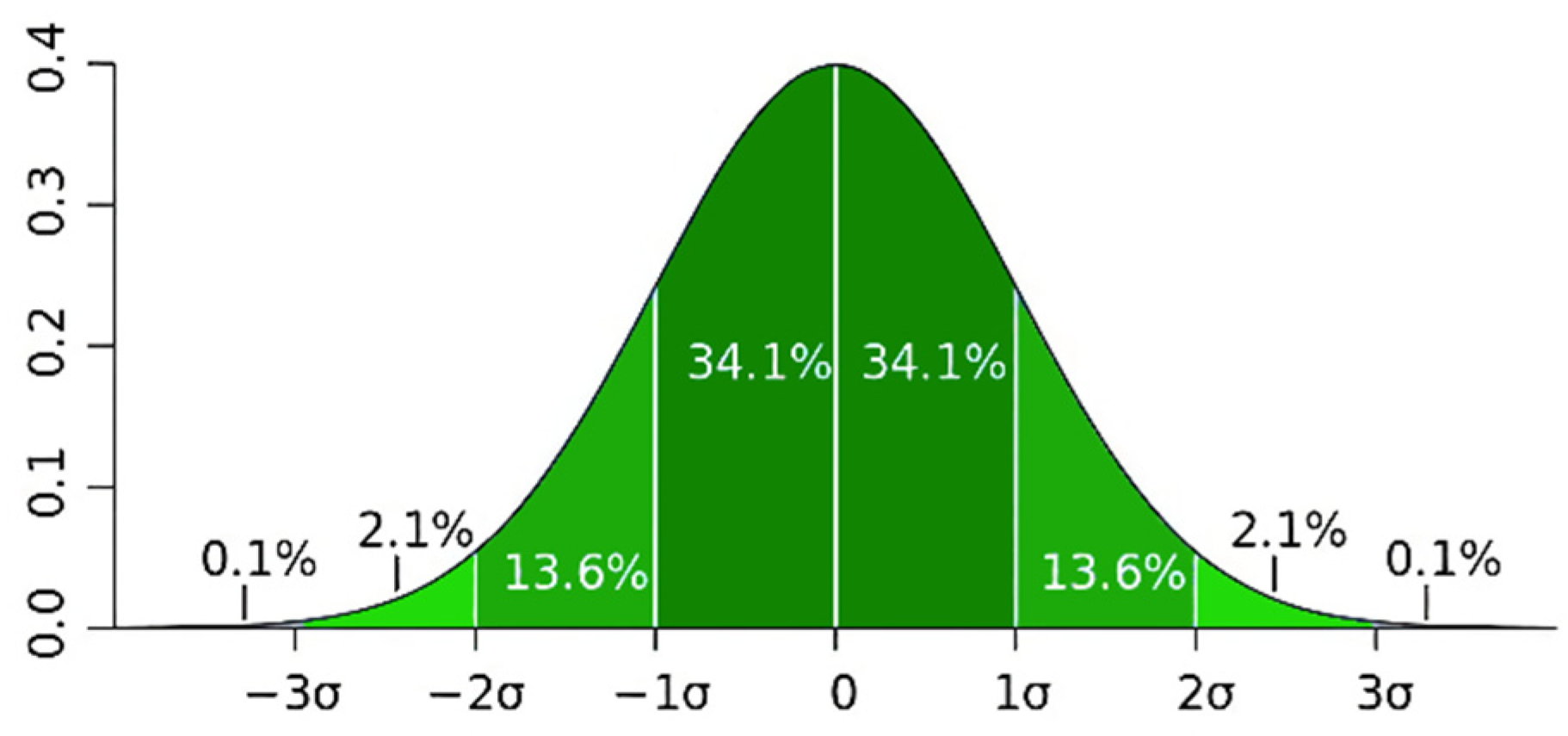
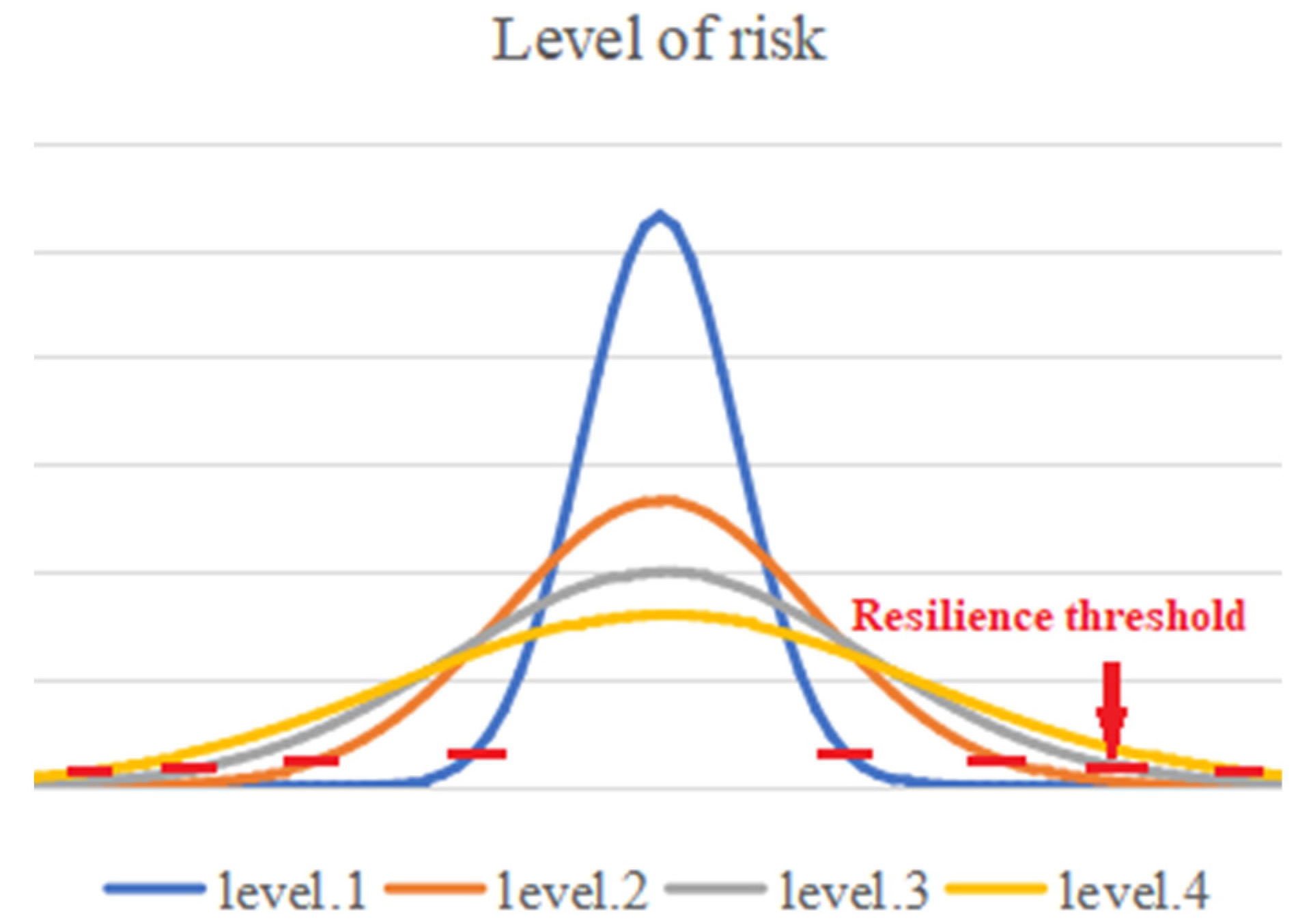
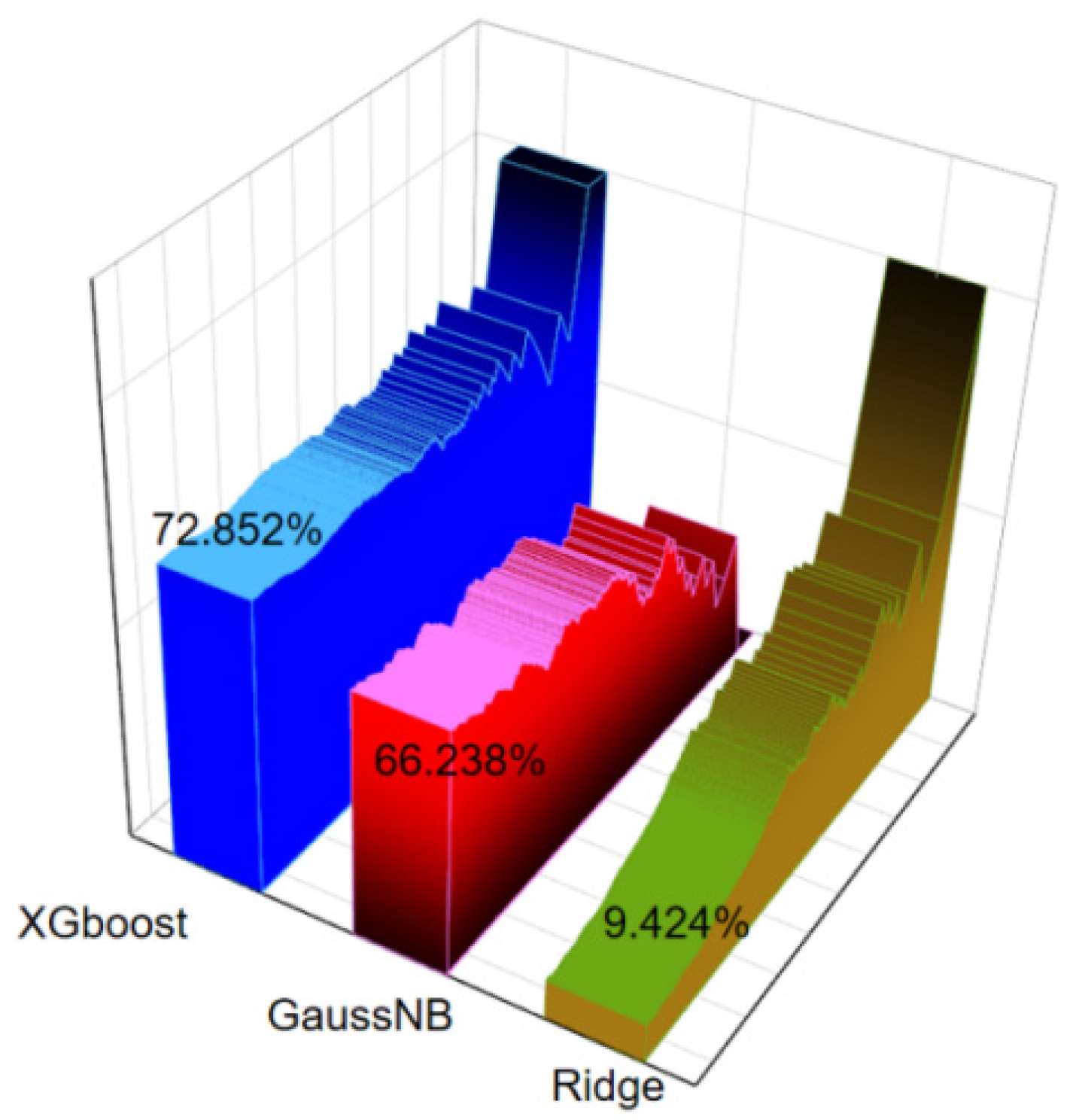

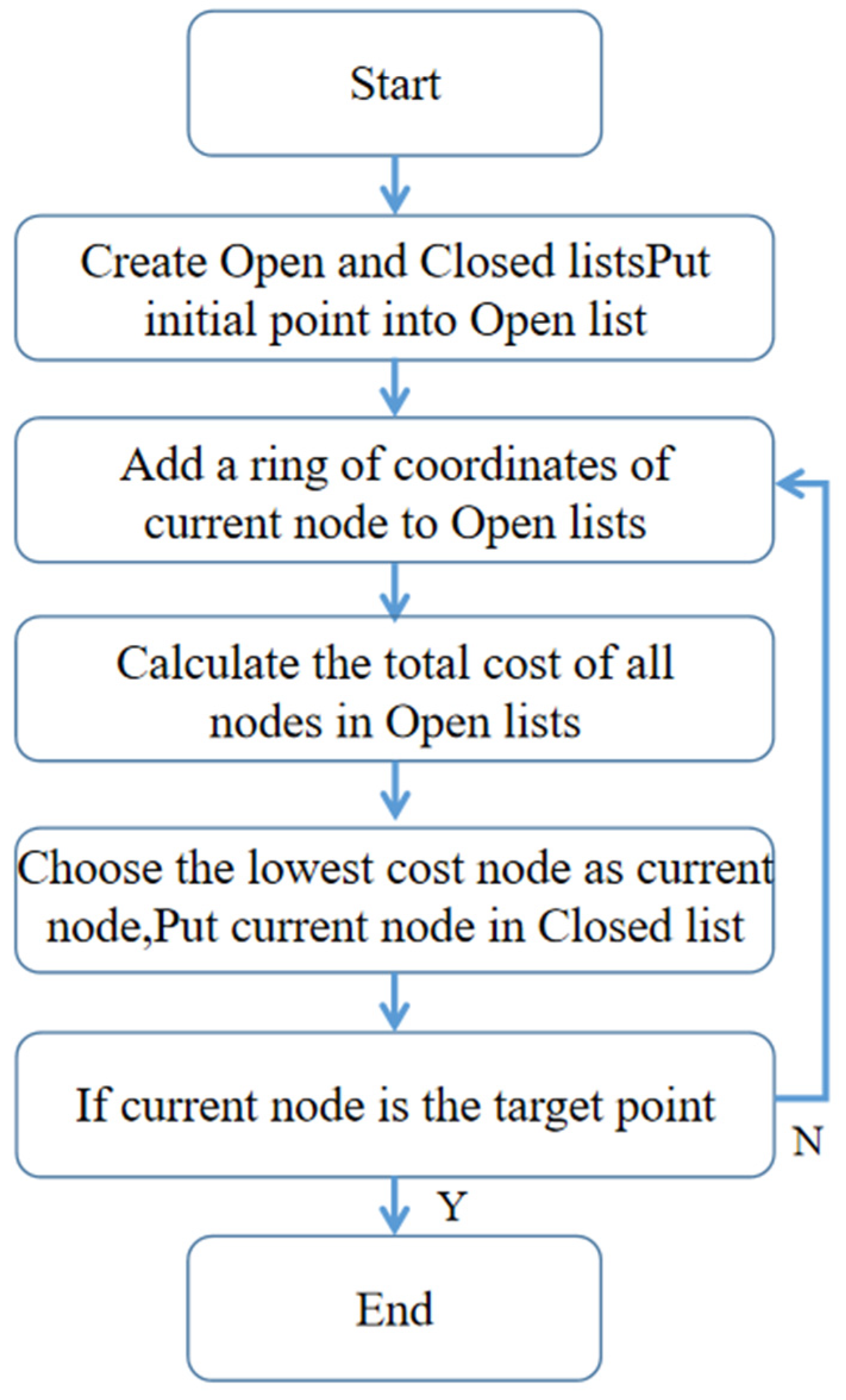
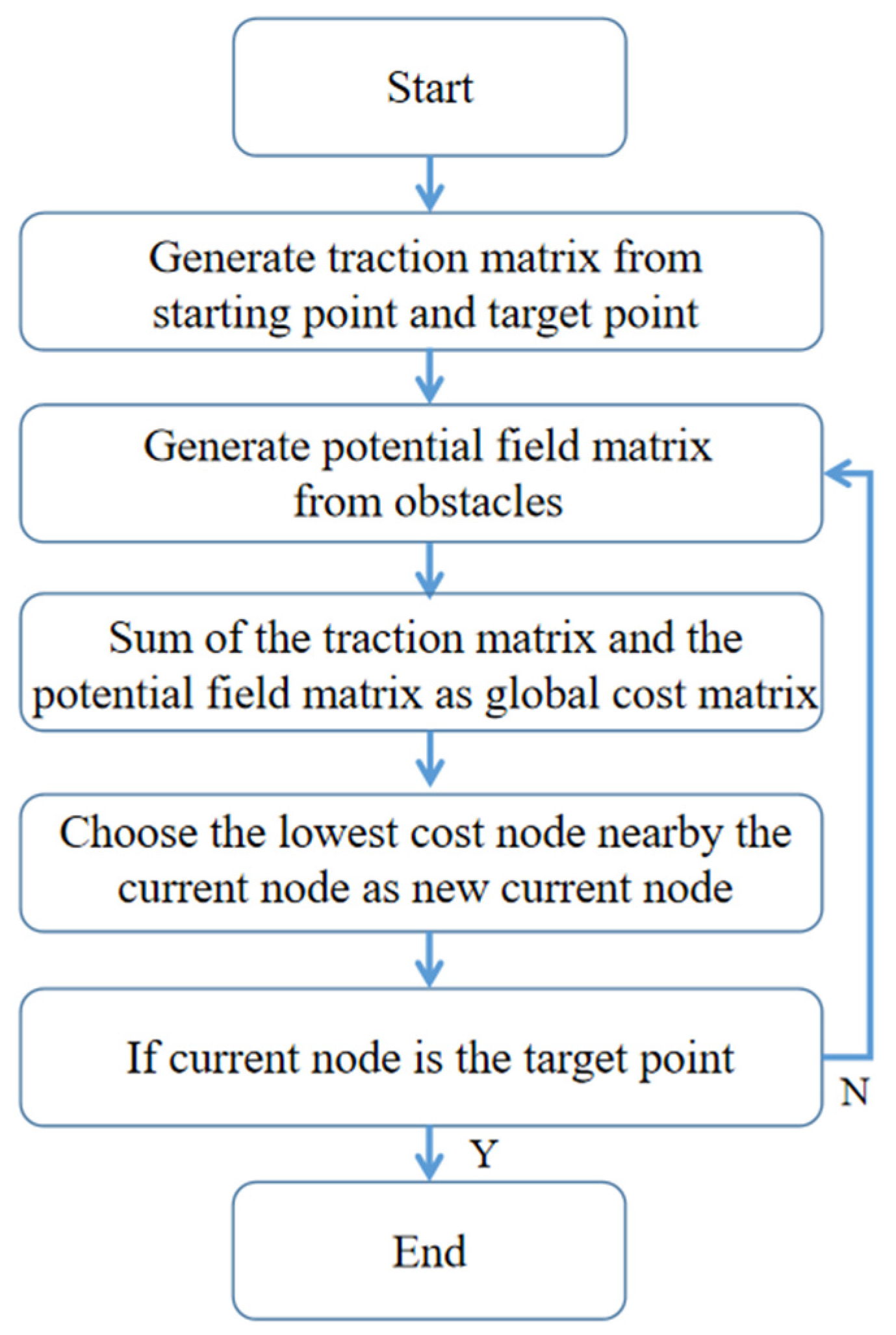
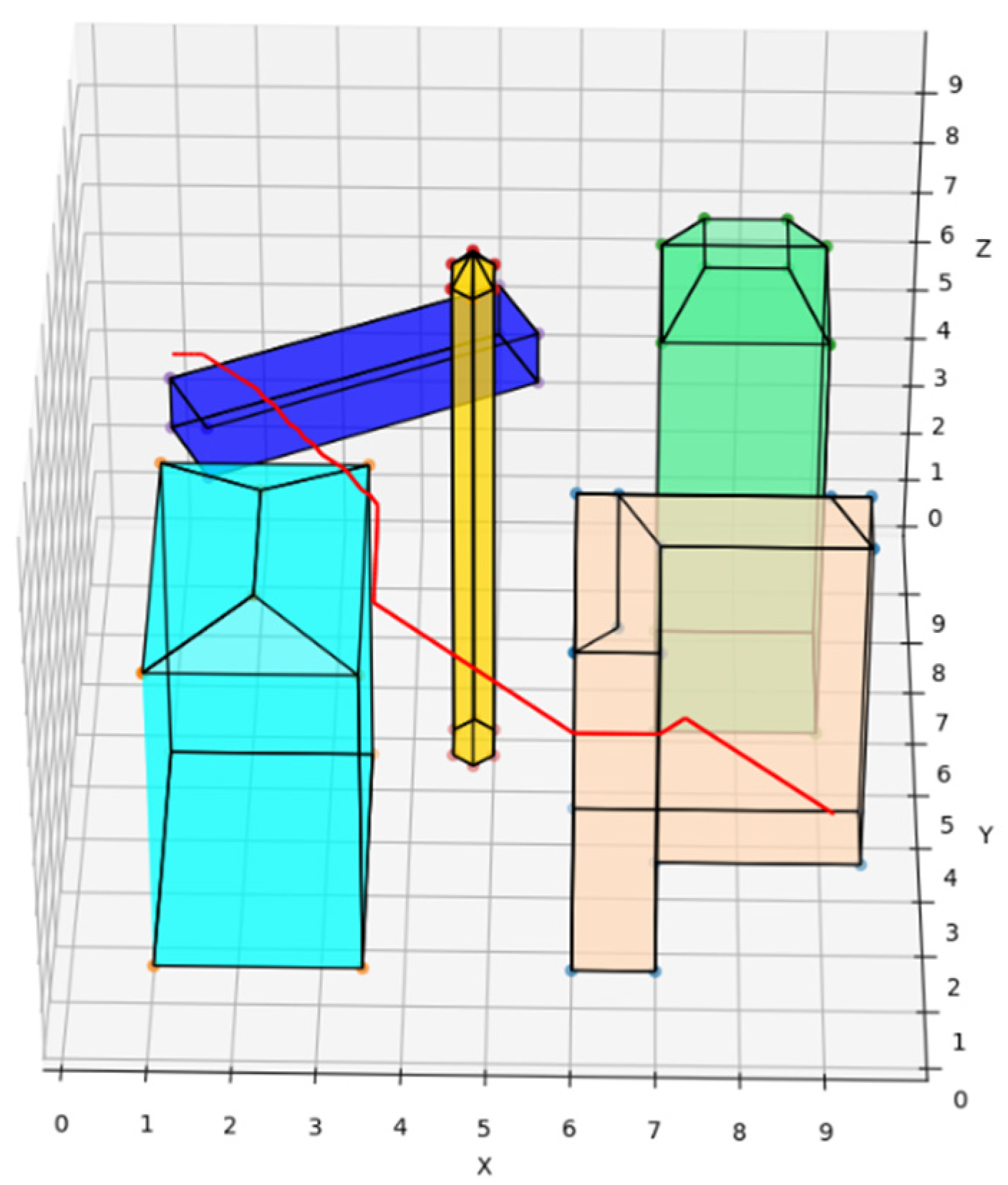
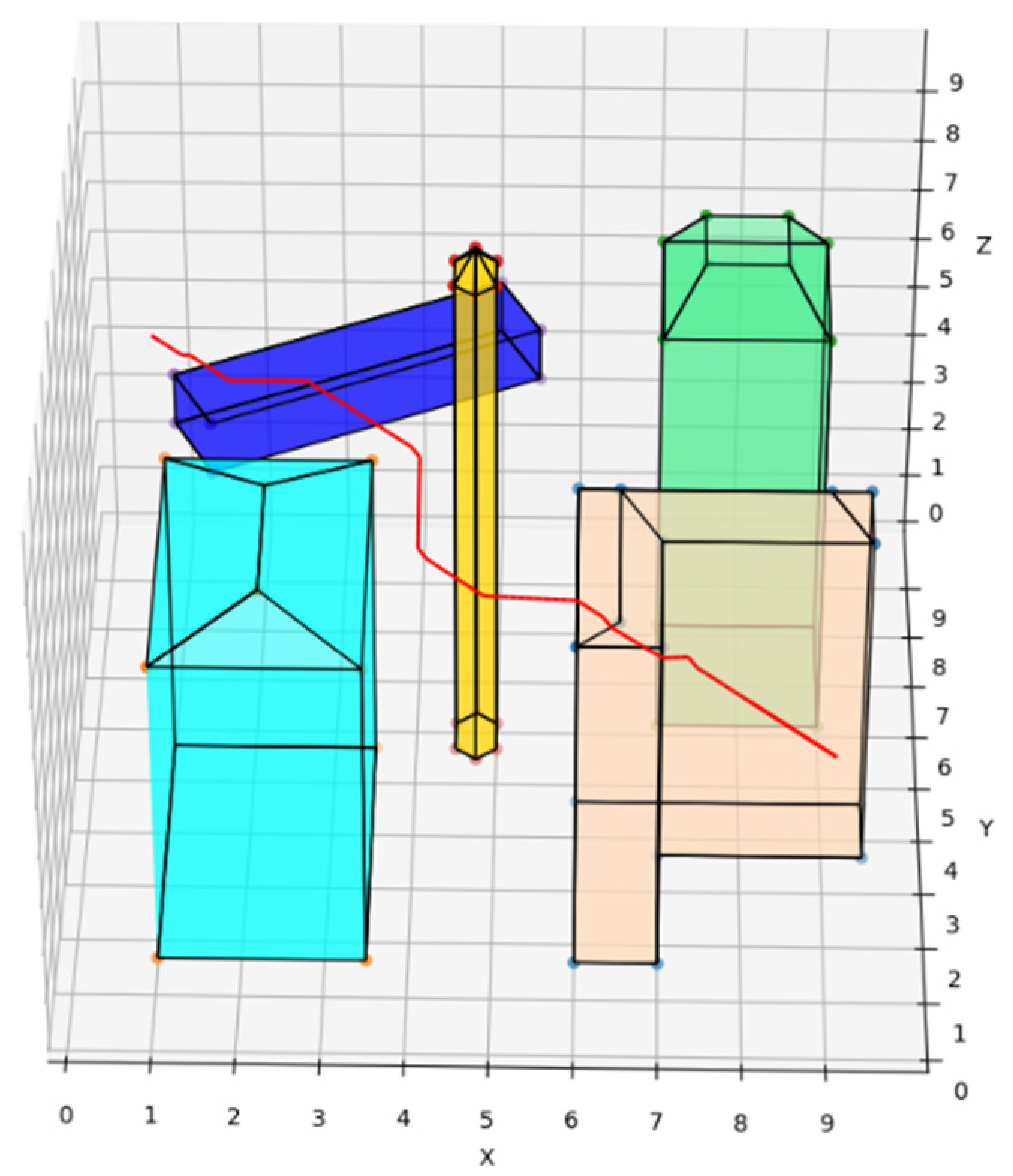
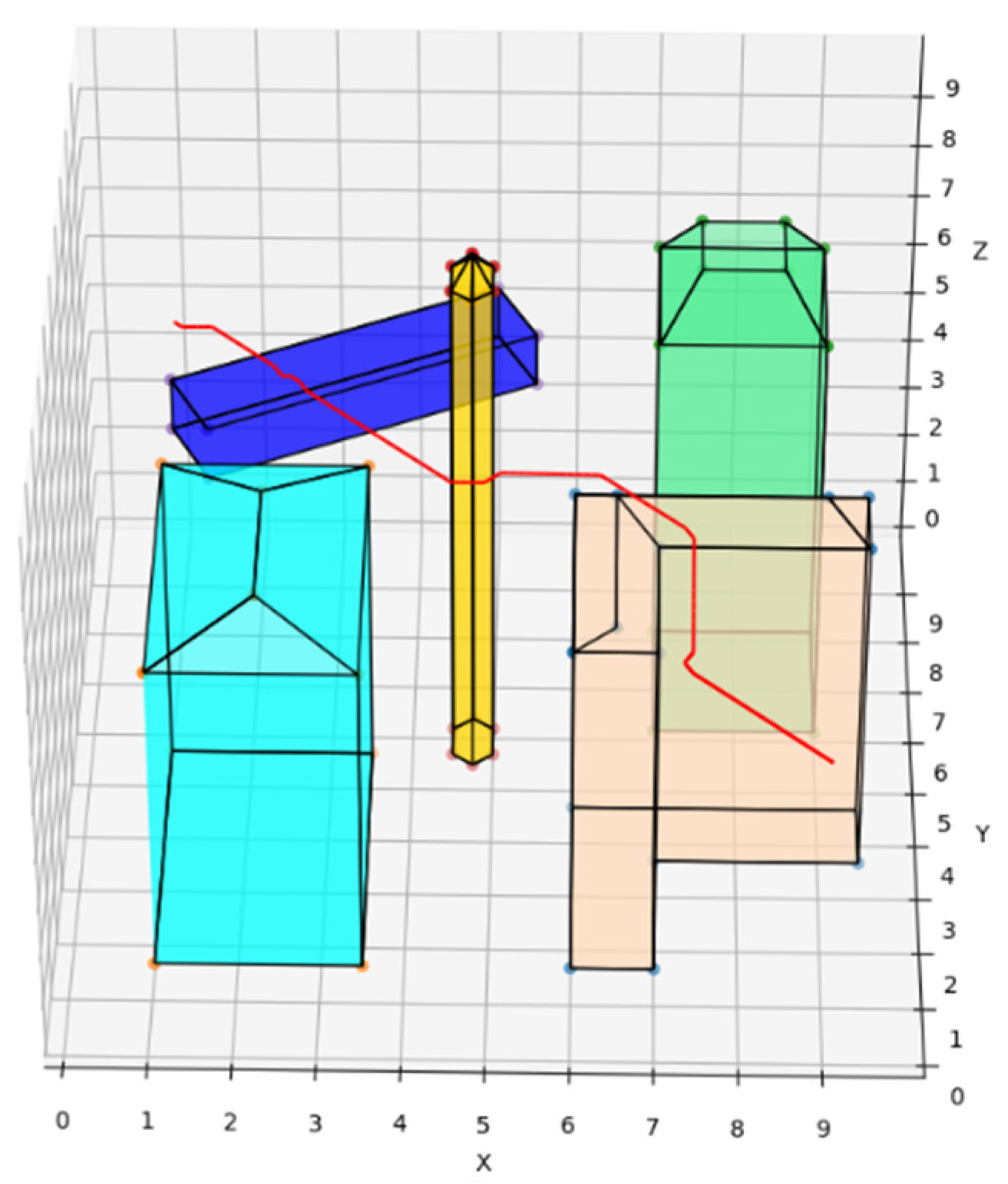

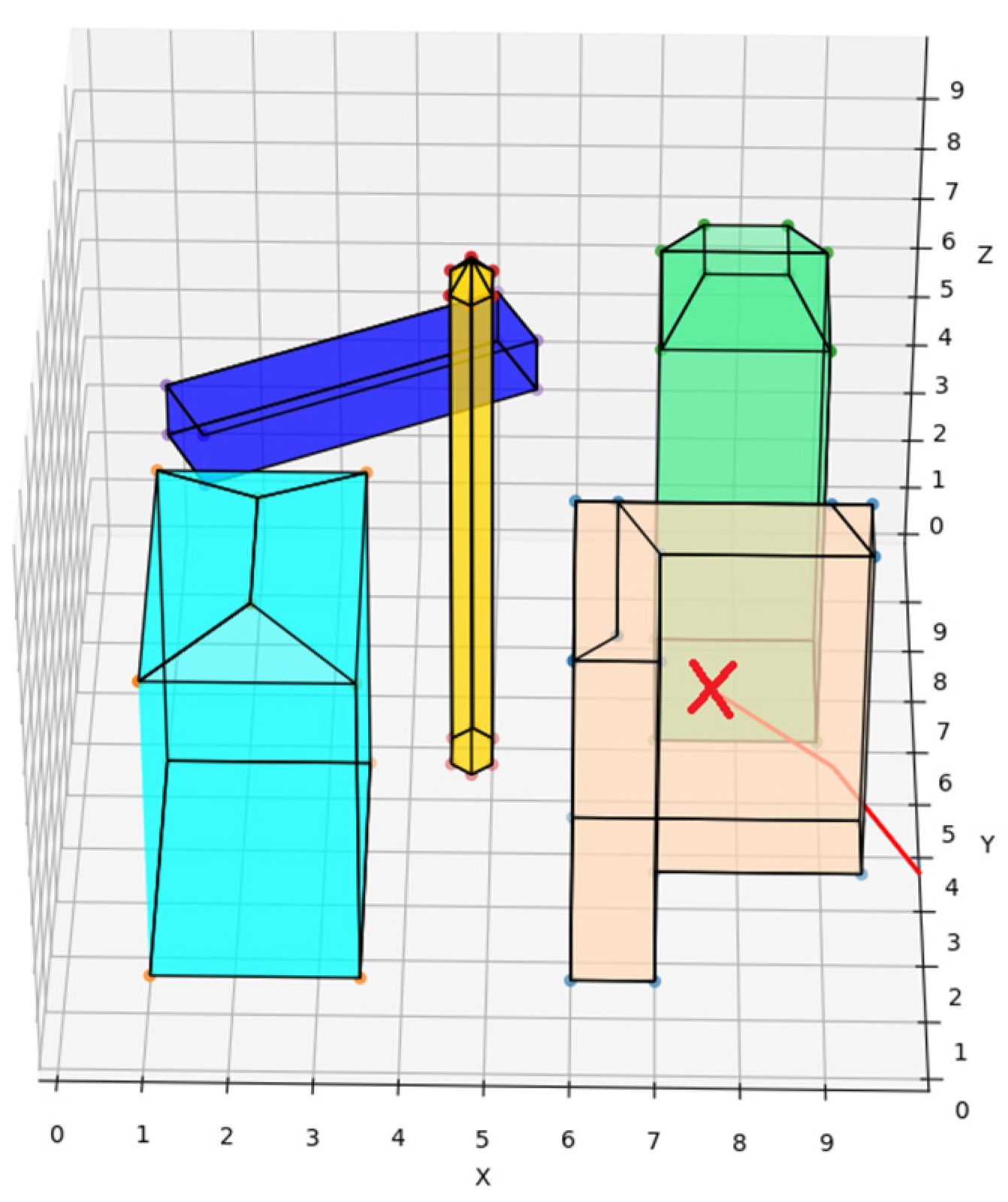
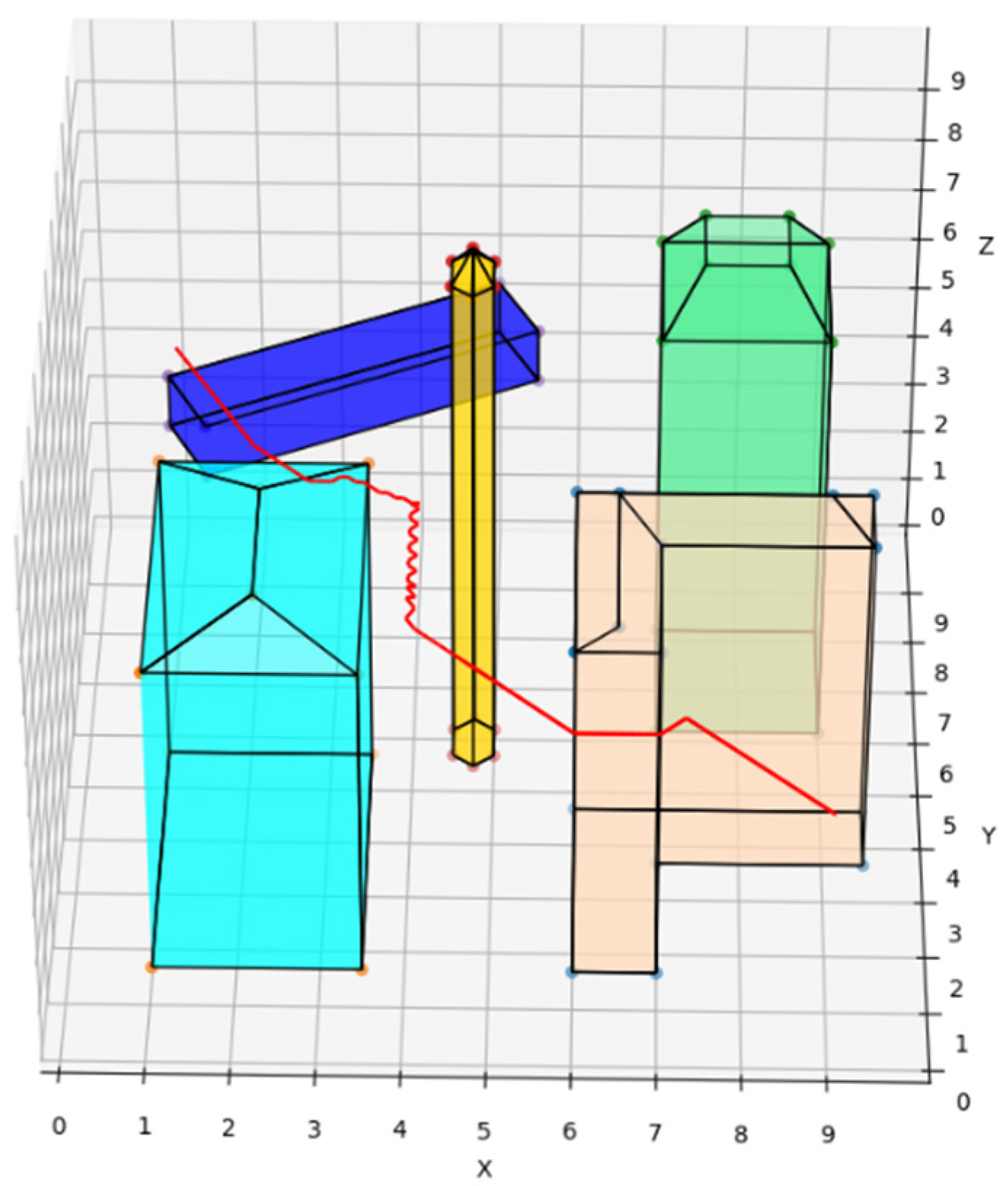

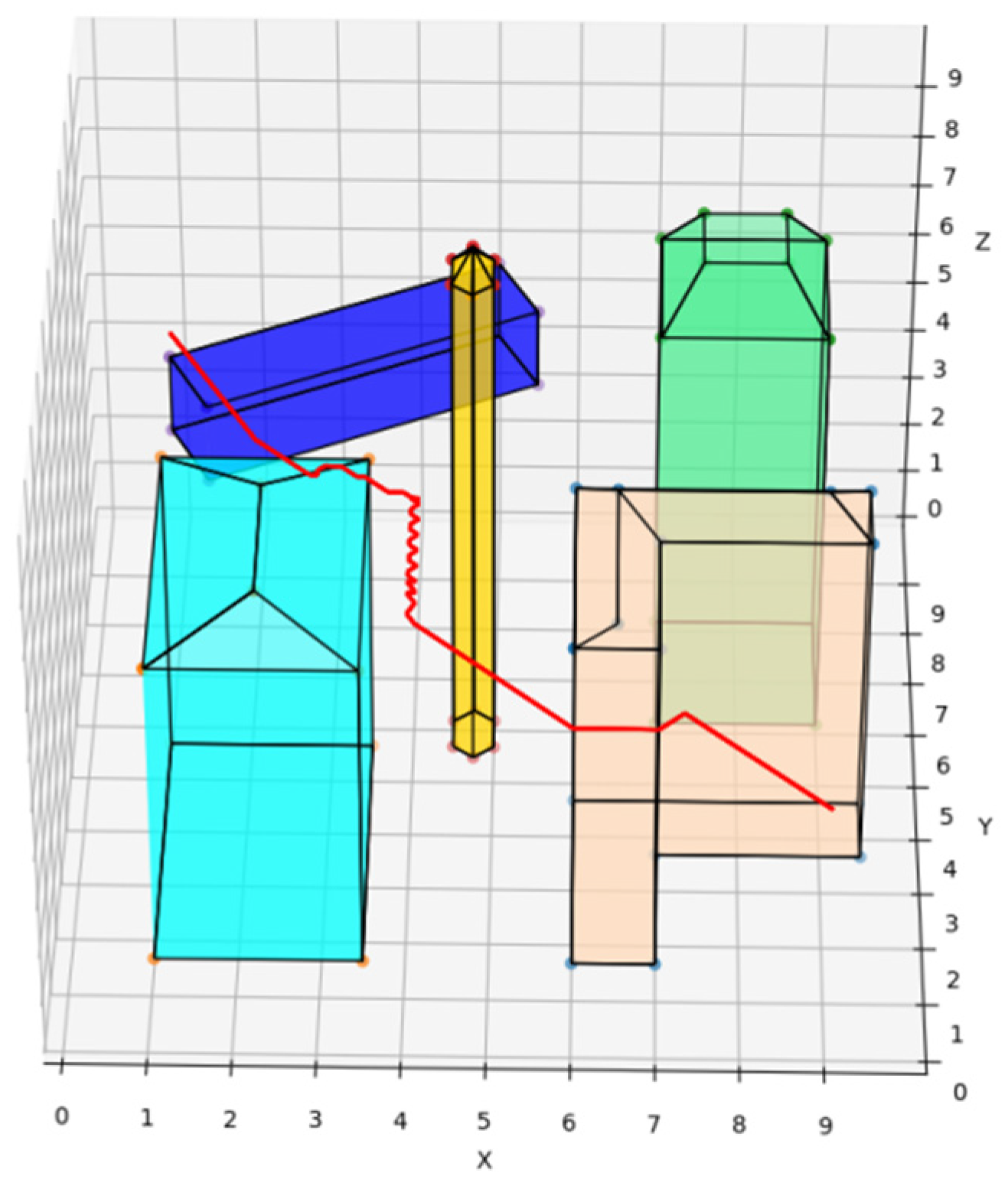

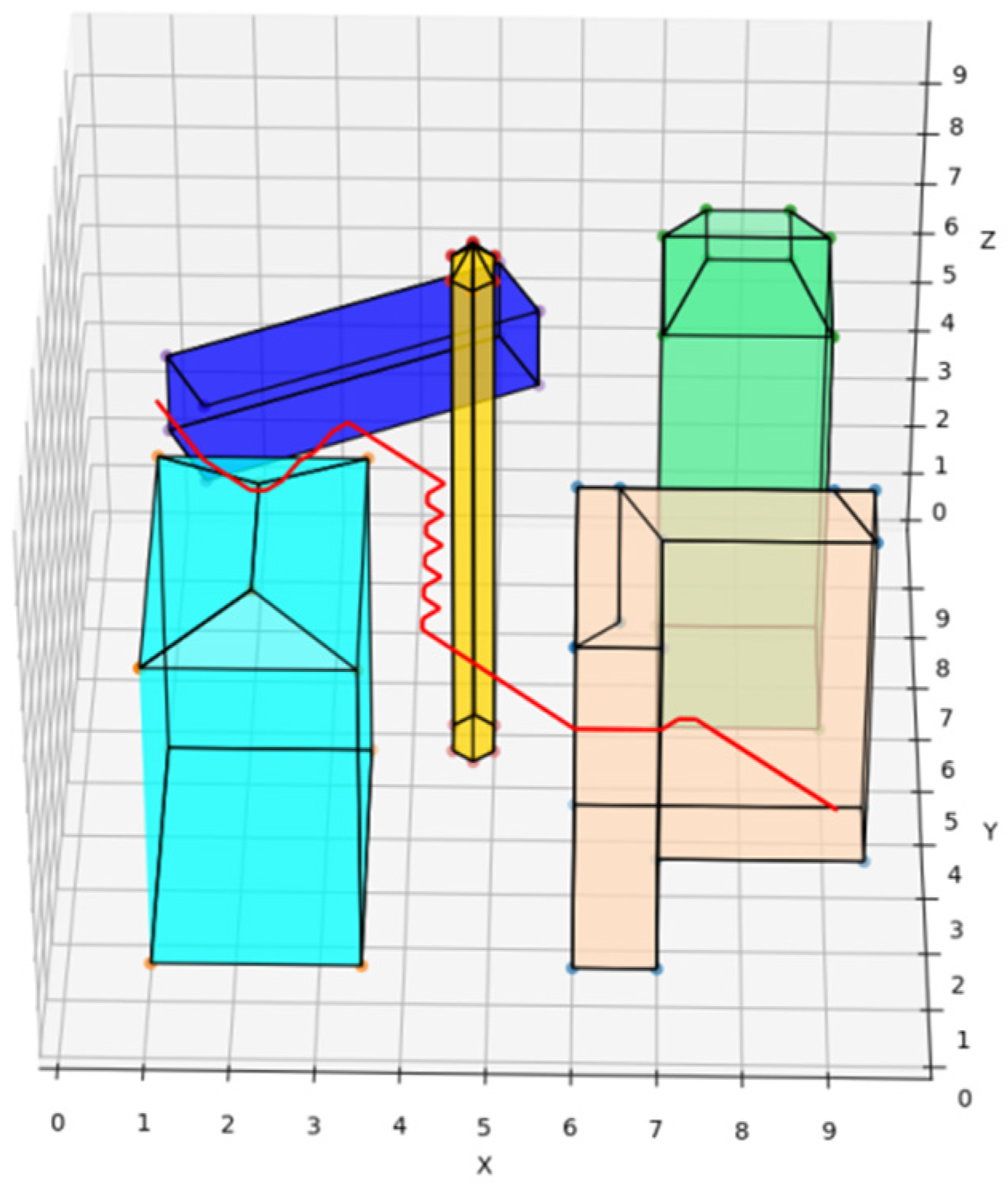
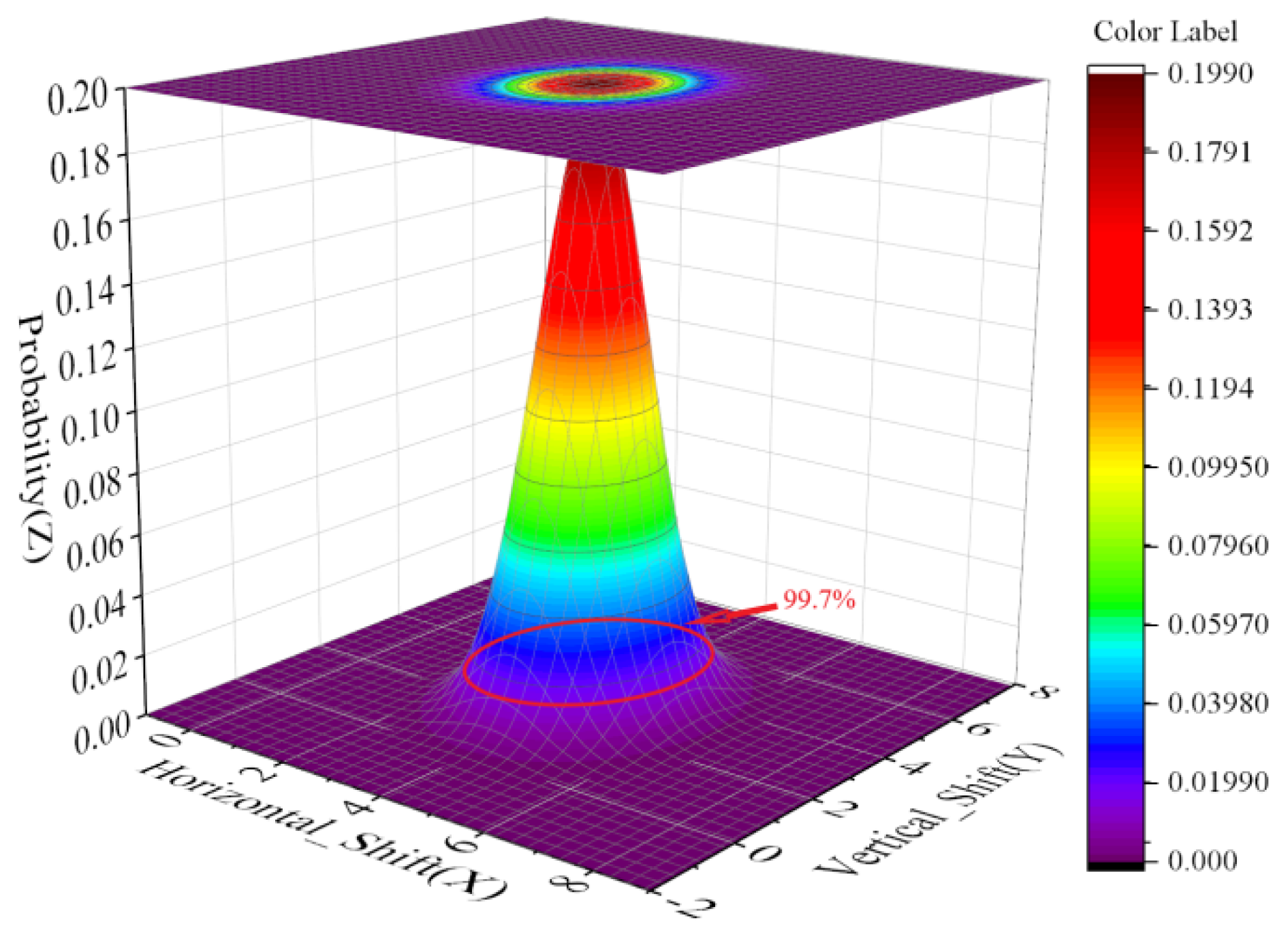
| No. | Coordinate of Nodes | Color |
|---|---|---|
| 1 | (70,15,0), (60,15,0), (60,45,0), (70,15,65), (95,35,0), (70,35,0), (60,15,65), (60,45,65), (95,45,0), (95,45,65), (95,35,65), (70,35,65), (65,15,70), (65,40,70), (90,40,70) | Peach puff |
| 2 | (10,15,0), (10,55,0), (35,55,0), (35,15,0), (10,15,60), (10,55,60), (35,55,60), (35,15,60), (22,25,65), (22,45,65) | Cyan |
| 3 | (70,60,0), (70,80,0), (90,80,0), (90,60,0), (70,60,80), (70,80,80), (90,80,80), (90,60,80), (75,65,90), (85,65,90), (85,75,90), (75,75,90) | Green |
| 4 | (15,65,45), (10,75,45), (50,95,45), (55,85,45), (15,65,60), (10,75,60), (50,95,60), (55,85,60) | Blue |
| 5 | (45,55,0), (48,53,0), (50,55,0), (50,60,0), (48,62,0), (45,60,0), (45,55,95), (48,53,95), (50,55,95), (50,60,95), (48,62,95), (45,60,95), (48,58,99) | Yellow |
| Algorithm | Route Distance | Time |
|---|---|---|
| Traditional A* route planning algorithm | 0.952 | 0.558 |
| Traditional artificial potential field route planning algorithm | 1 | 1 |
| REPARE | 0.973 | 0.655 |
| Load/Disturbance | Dead Load | Light Load | Moderate Load | Heavy Load |
|---|---|---|---|---|
| No disturbance | Resilience system shuts down | Resilience system shuts down | Lower resilience factor | Intermediate resilience factor |
| Mild disturbance | Lower resilience factor | Lower resilience factor | Intermediate resilience factor | Advanced resilience factor |
| Moderate disturbance | Intermediate resilience factor | Intermediate resilience factor | Advanced resilience factor | Advanced resilience factor |
| Heavy disturbance | Intermediate resilience factor | Advanced resilience factor | Grounded | Grounded |
| Condition | Resilience Factor | Minimum Safe Distance |
|---|---|---|
| light load and mild disturbance | Intermediate | 3.5 |
| heavy load and mild disturbance | Advanced | 4.5 |
| light load and heavy disturbance | Advanced | 5.5 |
Publisher’s Note: MDPI stays neutral with regard to jurisdictional claims in published maps and institutional affiliations. |
© 2022 by the authors. Licensee MDPI, Basel, Switzerland. This article is an open access article distributed under the terms and conditions of the Creative Commons Attribution (CC BY) license (https://creativecommons.org/licenses/by/4.0/).
Share and Cite
Xu, Z.; Zhang, L.; Ma, X.; Liu, Y.; Yang, L.; Yang, F. An Anti-Disturbance Resilience Enhanced Algorithm for UAV 3D Route Planning. Sensors 2022, 22, 2151. https://doi.org/10.3390/s22062151
Xu Z, Zhang L, Ma X, Liu Y, Yang L, Yang F. An Anti-Disturbance Resilience Enhanced Algorithm for UAV 3D Route Planning. Sensors. 2022; 22(6):2151. https://doi.org/10.3390/s22062151
Chicago/Turabian StyleXu, Zhining, Long Zhang, Xiaoshan Ma, Yang Liu, Lin Yang, and Feng Yang. 2022. "An Anti-Disturbance Resilience Enhanced Algorithm for UAV 3D Route Planning" Sensors 22, no. 6: 2151. https://doi.org/10.3390/s22062151
APA StyleXu, Z., Zhang, L., Ma, X., Liu, Y., Yang, L., & Yang, F. (2022). An Anti-Disturbance Resilience Enhanced Algorithm for UAV 3D Route Planning. Sensors, 22(6), 2151. https://doi.org/10.3390/s22062151






